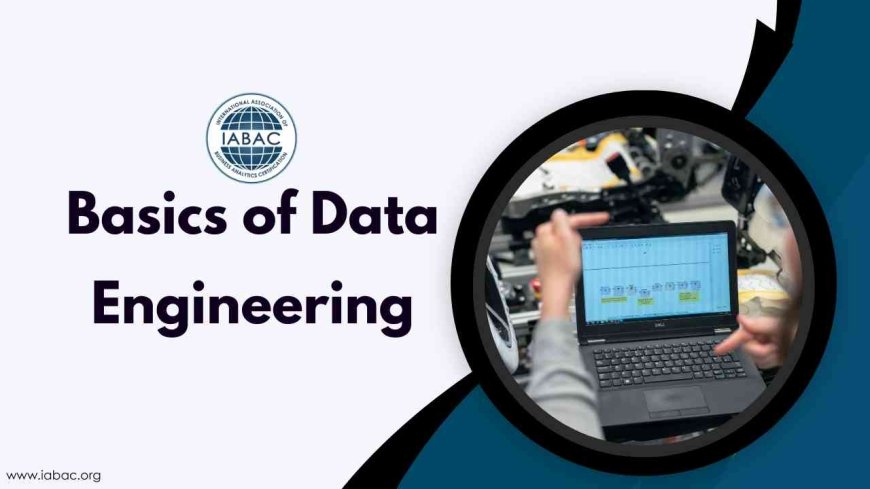Basics of Data Engineering
Get to know the basics of data engineering. Our guide covers important concepts, tools, and best practices for handling data pipelines efficiently.

Data Engineering is a key part of the tech world, essential for making smart decisions based on data. It involves creating and managing systems that gather, store, and analyze large amounts of data. With businesses relying more on data to guide their strategies, learning the basics of Data Engineering is increasingly important. At its core, Data Engineering focuses on building data pipelines that move data smoothly from various sources to storage systems and then to analysis tools. This involves three main steps: extracting data, transforming it into a useful format, and loading it into a system (ETL). Data Engineers use different technologies, including databases, data warehouses, and big data platforms, to handle large amounts of information effectively.
Understanding the basics of Data Engineering helps professionals see how data is organized and managed, leading to better data analysis and more informed decisions. Whether you're interested in starting a career in Data Engineering or just want to improve your knowledge, knowing these fundamentals is a great place to begin.
The Growing Importance of Data Engineering
The rise in data engineering is closely tied to the growing field of data science. Professionals with a solid data science foundation now recognize that good data engineering is vital for successful data science projects. With more companies looking for Certified Data Scientists and Certified Data Science Developers, data engineers must work closely with these experts to build strong and efficient systems.
Furthermore, the need for Certified Machine Learning Expert has increased as companies look to use advanced analytics and machine learning. These experts depend on the data infrastructure created by data engineers to implement and manage their models effectively. Similarly, Certified Data Science Managers need to oversee data engineering teams to ensure their organizations can fully use their data.
The Challenge of Data Engineering
Handling Data Engineering can be tough. One big issue is dealing with large amounts of data from different sources. Keeping data accurate and consistent is essential but often hard to achieve. Plus, using new tools and technologies needs a lot of skill. As businesses grow, they need more robust systems, making Data Engineering even more crucial and challenging. The fastchanging world of data technology adds another layer of difficulty, requiring continuous learning and adjustment. Balancing these needs while staying efficient is a major challenge for data engineers.
-
Managing large amounts of data from different sources.
-
Keeping data accurate and consistent.
-
Using new tools and technologies.
-
Adapting to fastchanging data technologies.
-
Balancing efficiency with growing system needs.
What are the most important basics of Data Engineering that beginners should understand?
1. Understanding Data Pipelines: Beginners in Data Engineering should grasp how data pipelines work. These pipelines are systems that collect, change, and store data. Learning how to set up and manage these pipelines ensures that data moves smoothly from its source to where it is stored.
2. Familiarity with Databases: Data Engineers need to know different types of databases, like MySQL for relational data and MongoDB for NoSQL data. Knowing which database to use and when is crucial for managing data effectively.
3. Data Modeling Skills: Data modeling involves designing how data is organized and used. Beginners should learn how to create schemas and models that fit business needs and keep data accurate.
4. Knowledge of ETL Processes: ETL stands for Extract, Transform, Load. This process involves pulling data from various sources, changing it into a useful format, and loading it into a data warehouse. Understanding ETL is essential for handling large amounts of data and maintaining data quality.
5. Proficiency in Programming Languages: Data Engineers often use programming languages like Python, Java, or Scala to build and manage data systems. Beginners should focus on learning these languages and how they apply to Data Engineering tasks.
6. Familiarity with Data Warehousing Solutions: Tools like Amazon Redshift or Google BigQuery are used to store and analyze large amounts of data. Knowing how to use these tools is a key skill for Data Engineers.
Key Fundamentals of Data Engineering
Data Engineering is a vital part of data science and analytics. It involves creating and managing systems that handle and process data. Here are the main basics you need to know:
1. Data Architecture Design
Definition: Planning how data will be stored and accessed.
Key Tasks: Designing databases, data warehouses, and data lakes to make sure data can be easily accessed and managed.
2. Data Pipeline Development
Definition: Building systems to move and transform data from one place to another.
Key Tasks: Setting up ETL (Extract, Transform, Load) processes to keep data clean, accurate, and ready for use.
3. Data Integration
Definition: Combining data from different sources into one view.
Key Tasks: Using tools and methods to merge different data sets, making sure they are consistent and reliable.
4. Data Quality Management
Definition: Keeping data accurate and consistent.
Key Tasks: Adding checks and cleaning processes to keep data quality high.
5. Database Management
Definition: Managing how databases run and perform.
Key Tasks: Handling database performance, indexing, and backups to keep things running smoothly and ensure recovery.
6. Big Data Technologies
Definition: Using tools to work with large amounts of data.
Key Tasks: Using technologies like Hadoop, Spark, and cloud solutions to handle and analyze big data efficiently.
7. Data Security
Definition: Protecting data from unauthorized access and breaches.
Key Tasks: Setting up encryption, access controls, and monitoring to keep sensitive information safe.
Data Engineering is essential for turning raw data into useful insights. Understanding these basics will help you build and manage effective data systems. For more information on the field and resources, check out platforms like IABAC.





























